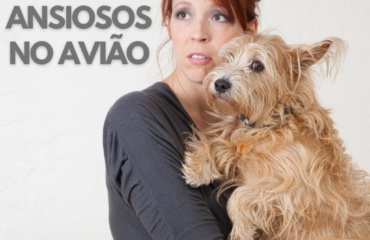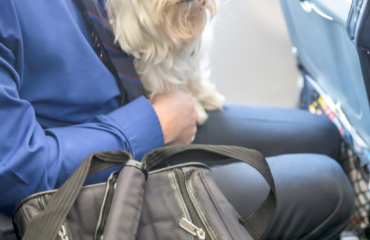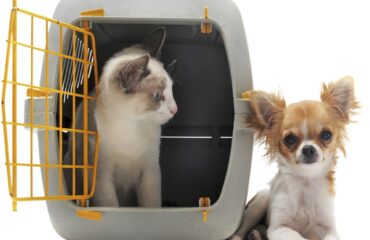
The transport of animals on national and international flights is something that needs a lot of attention and planning to make the journey simple and peaceful for the pet.
Although pet owners prefer to travel with their pets in the cabin, it is not always possible to have access to all the information.
Whether required by the company or the country of destination.
Now, if you want to know more about this subject, keep reading this article thatPETFriendly Turismo has prepared for you about the transport of animals.
The importance of transporting animals by plane
Traveling abroad with pets can be a long and uncomfortable experience.
After all, when leaving the country, it is necessary to use this method of displacement, and not leave your pet aside.
And, as we said before, understanding the types of transport suitable for each situation and for each animal makes a difference in different aspects, such as:
- stress;
- comfort;
- among others.
So the more prepared he is, the better.
In addition, each company has its own rules for transporting animals, so you need to keep an eye on each one before packing your bags.
The main types of animal transport
Usually pets travel in the cabin of the plane or in the hold, however they can still be transported as live cargo.
In addition, the transport of guide dogs and support animals has special rules.
Check out some of the main characteristics of the Brazilian airlines most used for international travel below.
1. PET in the Cabin

Most airlines allow the transport of animals in the aircraft cabin, as long as they are small and at least four months old.
Dogs and cats must travel inside a clean and secure kennel under the seat in front of them.
Although the documentation is practically the same for all companies, they have specific requirements regarding the weight and dimension of the box,
See:
- Azul: charges a fee of R$250 per section, for the transport of animals weighing a maximum of 5kg, depending on the weight of the box;
- Goal: the dog or cat plus the kennel can weigh up to 10kg. The amount charged is R$250 per segment on domestic flights and R$600 for international flights;
LATAM the total weight cannot exceed 10kg. The service costs R$200 each way.
2. Excess Baggage

When the total weight of the dog or cat plus the kennel exceeds that allowed by the airline, they must travel in the hold of the aircraft their owner is on.
Usually, airlines transport animals weighing up to 45kg and require the box to be up to 115 cm high and 300 cm linear (sum of height, width and length);
In addition, they must be made of plastic, metal or wood and the grille must be made of metal, as specified by the International Air Transport Association (IATA).
3. Live Load

Some countries do not allow foreign animals traveling in the cabin or hold of the aircraft and therefore require that they be shipped as live cargo.
In this sense, the tutor must hire a customs officer and buy the space where your pet will travel, which can be in the hold of a commercial aircraft or a cargo plane.
OUnited Kingdom, for example, it still requires a local company to be hired to release the dog or cat at the airport.
When transporting animals as live cargo, the kennel must have 68cm x 50cm x 48cm (length x width x height) and strong enough to protect the dog or cat, in addition to having ventilation on all four sides.
4. Guide dog

Animals specially trained to help the visually impaired can travel alongside their owners, out of the box, free of charge.
Still, to travel withguide dogs, it is I need to submit the following documentation:
- Proof of training;
- Vaccination record;
- Proof of valid rabies vaccine;
- International Zoosanitary Certificate (CZI), in cases international travel.
Both the Goal and the Latam ask that passengers inform their intention to travel with the guide dog 48h before the flight.
5. emotional assistance animal

Unlike guide dogs, pets that are essential for the treatment of owners with psychological or chronic illnesses must follow the general rules when traveling within Brazil.
This is because the country still does not have specific legislation for animals de emotional assistance.
On the other hand, if you are traveling to Colombia, the United States or Mexico, your support pet can travel alongside you for free.
However, the allowed destination varies by airline, so it is always necessary to seek more specific information on these occasions.
Blue
Support dogs, at least four months old, are only allowed when traveling to the United States.
In addition to the vaccination card, CVI and medical certificate, the tutor must send a Azul’s Emotional Support Animal Declaration to the company 72 hours before the flight.
Goal
The company allows support dogs on trips to the USA and Cancun (MEX), but for that, the passenger must choose a window seat and carry a collar, muzzle and a mat for the animal’s needs.
In addition to the documents required for boarding an aircraft, you must present:
- Application Form for Transport of Animals;
- Declaration by a doctor attesting to the animal’s need for the guardian’s well-being
All documents must be sent 72 hours before the flight to the email: [email protected] .
Latam
On trips to Colombia, the United States and Mexico, the emotional assistance pet travels at the owner’s feet, as long as it stays close to the emergency exits and shows good behavior. thiscontact form, with this application attached.
Cautions when planning to transport animals by plane
In addition to understanding the specifications of each mode of transport, tutors must pay attention to the documentation, vaccines and dimensions of the kennel.
Therefore, learn about some basic care before moving with your pet!
1. Check the documentation for transporting animals
On domestic travel, only the animal’s vaccination card and health certificate are required.
For international ones, tutors must provide the CZI, as well as microchipping, depending on the destination.
2. Get your pet fully vaccinated
Generally, countries require that foreign pets have been vaccinated against rabies within 30 days of travel.
However, destinations likeJapan only allow entry of dogs and cats that have performed the serology of the disease.
So, before traveling, check out what the country’s requirements are regarding vaccines and also worming.
3. Pay attention to the size of the Kennel for transporting animals
Generally, companies require pets to travel in rigid or flexible crates with enough space for them to stand or move around in a circle around themselves.
In addition, the kennel must be made of resistant and waterproof material and contain structures that prevent the animal from leaving.
Dimensions vary from one company to another, check:







You must be logged in to post a comment.